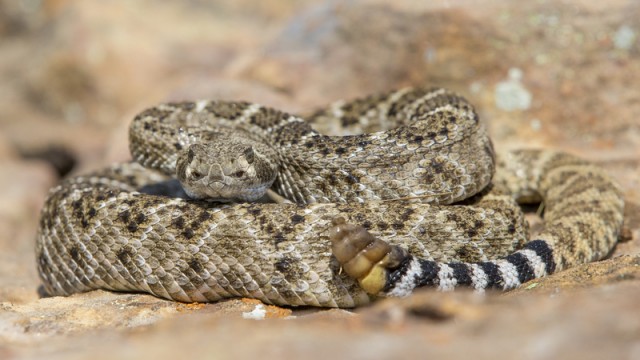The western diamond-backed rattlesnake is a bigger one, so it can be easier to spot, but that doesn’t mean it’s safe to get close to one! Like its relatives, this rattler blends in with its surroundings and is mostly encountered around late summer and early fall.
4 -Western Diamond-Backed Rattlesnake
WESTERN DIAMOND-BACKED RATTLESNAKE (Crotalus atrox). Length 4-5 feet, although some are larger. In the United States, probably more deaths are caused by this snake than by any other. A combination of large size, wide distribution, abundance, and touchy temperament give this distinction to this snake. It is rather common in Oklahoma, just south of this region. The diamond-back prefers dry open plains and canyons, where it feeds upon small rodents, young rabbits, and occasionally, birds. The ground color varies somewhat from buff to gray; the snake generally has a faded appearance. The black and white tail bands are distinctive.
About ten young are born in late summer or early fall. Larger litters have been recorded. The young are fully capable of inflicting a dangerous bite as soon as they are born – and quite willing to do so!
At least the diamond-back tends to live in the wilderness, but next on our list is a snake that feels at home living close to human habitations! Not only may you encounter this snake near in the woods, it may also be found near your home! Learn how to identify it and find out just how dangerous this snake is!


Yes Obama. Clinton,Schumer palosi. McCain, cnn
Well , they all look democRATS ,but they are so many of them it’s hard to identify them.
I can identify them only in soup or stews,they fast different .
#1 John mccain#2loretta lynch#3 Hillary clinton#4 jey johnson#6 Maxine Watters,#5obama#
Lynch,OBumer,Schumer ,Pelosie
–
Chuck Shumer
Nancy Pelosi
Elizabeth Warren
John McCain
Maxine Waters
Hillary Clinton
Nope
Guessing here…copperhead, water moccasin, and 2rattlesnakes…..one might be a sidewinder?
Dead snake!
The most important detail about snake bites is the statistic that the great majority of them occur because the victim tried to handle, or kill the snake. They’re easily as afraid of humans as we are them, so just leave them alone.